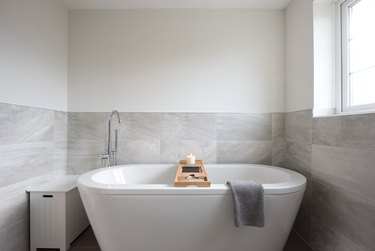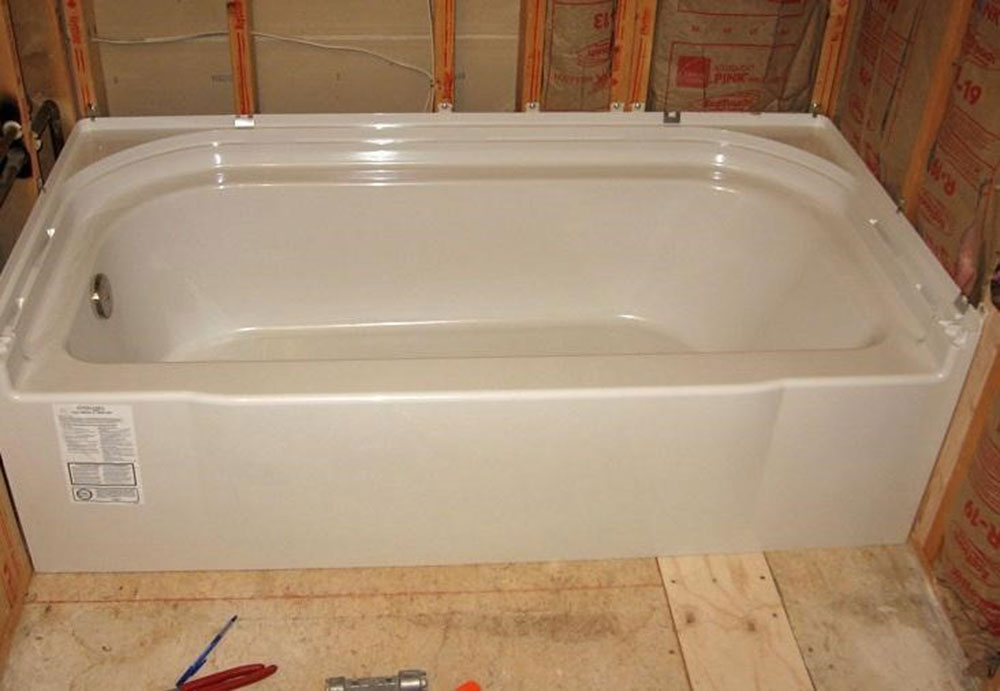A Step-by-Step Guide to Setting Up a Tub
A Step-by-Step Guide to Setting Up a Tub
Blog Article
Everyone has got their own unique idea in relation to How to Install a Bathtub: Install an Acrylic Tub and Tub Surround.

Mounting a bathtub isn't precisely rocket science, however it does require solid plumbing, woodworking, and often, tiling skills. Changing an old tub with a new one is likewise a reasonably challenging job. If the old bathtub is readily easily accessible, the job can relocate speedily; if you have to open up a wall surface to get rid of the old tub and also position the brand-new bath tub, the task is much harder. In either situation, the task is within a house handyman's abilities, although you will require an assistant to vacate the old tub as well as embeded in the brand-new one. Make sure you have actually qualified yourself for the task as well as fit trying it. Rather than hiring a specialist to take control of a halfway-completed task, it is better to take into consideration employing one before you start. Possibilities are you might require a specialist plumber to make tube links.
This write-up will assist you install a brand-new bathtub in your bathroom if you have already bought a new bathtub and also do not require to alter the plan of your previous water system pipes.
Your tools and material list need to comprise the following:
Removing Old Touches
If you require to change old taps with new ones as a part of your setup, after that the first thing you must do is separate the water system. After doing so, activate the faucets to drain pipes any water staying in the system. The process of removing the existing taps can be rather troublesome because of the limited accessibility that is usually the instance.
Use a basin wrench (crowsfoot spanner) or a tap tool to undo the nut that attaches the supply pipelines to the faucets. Have a towel all set for the continuing to be water that will certainly originate from the pipelines. As soon as the supply pipelines have been eliminated, utilize the exact same tool to loosen up the nut that holds the faucets onto the bath/basin. You will certainly require to quit the solitary faucets from turning during this process. Once the taps have actually been gotten rid of, the holes in the bath/basin will certainly need to be cleaned up of any type of old sealing compound.
Prior to carrying on to fit the new taps, contrast the pipeline connections on the old faucets to the new taps. If the old faucets are longer than the brand-new faucets, after that a shank adapter is required for the new faucets to fit.
Fitting New Taps
If the tails of the brand-new faucets are plastic, after that you will need a plastic connector to prevent damages to the thread. One end of the connector fits on the plastic tail of the faucet and also the other end offers a connection to the existent supply pipelines.
If you require to fit a monobloc, then you will certainly need decreasing couplers, which connects the 10mm pipeline of the monobloc to the conventional 15mm supply pipe.
Next off, place the tap in the mounting opening in the bath/basin making certain that the washing machines are in place in between the faucet and the sink. Secure the faucet in place with the supplier supplied backnut. When the tap is firmly in place, the supply pipelines can be linked to the tails of the taps. The faucets can either be linked by using corrugated copper piping or with regular faucet connectors. The former type needs to be linked to the faucet finishes first, tightening just by hand. The supply pipelines can later be connected to the other end. Tighten up both ends with a spanner after both ends have actually been attached.
Setting up the Tub
Making use of both wooden boards under its feet, place the bathtub in the required placement. The wood boards are valuable in evenly spreading out the weight of the tub over the area of the boards rather than focusing all the weight onto 4 little factors.
The next objective is to make sure that the tub is leveled all round. This can be attained by inspecting the spirit level and also changing the feet on the bathtub till the level checks out degree.
To install faucets, fit the bottom of the furthest flexible faucet port to the appropriate supply pipeline by making a compression join; after that do the exact same for the various other faucet.
Activate the water system and inspect all joints and new pipework for leakages as well as tighten them if essential. Fill up the bath tub as well as likewise examine the overflow outlet and the typical outlet for leakages.
Finally, take care of the bath paneling as explained in the supplier's instruction manual. Tiling and also sealing around the tub must wait till the bathtub has been utilized at the very least once as this will settle it right into its last position.
Getting ready for the Installment
Firstly, the sustaining structure supplied with the bath ought to be fitted (if called for) according to the supplier's instructions. Next, fit the faucets or mixer to the bath tub. When suitable the tap block, it is very important to see to it that if the tap comes with a plastic washer, it is fitted between the bathroom and the taps. On a plastic bathroom, it is additionally reasonable to fit a sustaining plate under the faucets system to avoid stress on the tub.
Fit the versatile tap ports to the bottom of the two taps using 2 nuts and olives (often provided with the tub). Fit the plug-hole electrical outlet by smearing mastic filler round the sink electrical outlet opening, and afterwards pass the electrical outlet through the hole in the bath. Use the nut supplied by the producer to fit the plug-hole. Take a look at the plug-hole electrical outlet for an inlet on the side for the overflow pipe.
Next, fit the end of the flexible overflow pipe to the overflow outlet. After that, screw the pipe to the overflow face which should be fitted inside the bath. Ensure you utilize all of the supplied washers.
Link the catch to the bottom of the waste electrical outlet on the tub by winding the thread of the waste outlet with silicone mastic or PTFE tape, and screw on the catch to the electrical outlet. Attach all-time low of the overflow tube in a comparable manner.The bathroom must currently prepare to be fitted in its final placement.
Tiling Around the Bath tub
In the location where the bath meets the floor tile, it is needed to seal the joins with a silicone rubber caulking. This is important as the installation can relocate enough to crack a stiff seal, causing the water to permeate the wall in between the bath and the tiling, bring about issues with dampness and also feasible leaks to the ceiling listed below.
You can pick from a range of coloured sealants to assimilate your components as well as fittings. They are marketed in tubes as well as cartridges, and can securing gaps approximately a width of 3mm (1/8 inch). If you have a bigger space to load, you can load it with spins of soaked newspaper or soft rope. Remember to constantly fill up the tub with water before securing, to permit the motion experienced when the tub remains in usage. The sealant can crack rather early if you do not consider this motion before securing.
Additionally, ceramic coving or quadrant tiles can be made use of to edge the bath or shower tray. Plastic strips of coving, which are easy to use and also cut to size, are additionally quickly available on the marketplace. It is suggested to fit the ceramic tiles utilizing waterproof or water-proof adhesive and also grout.
Bathtub Installation
How Important Is A Bathtub To Your Home?
High-quality baths, showers, and other bathroom updates are necessary when considering a smart investment in your home. It’s a room that you go to every day and one that is constantly being used by guests.The bathroom is one of the top trafficked rooms in a home and also one of the most valuable in terms of home resale.
Install Piping Before Tub
You will be using your existing drain and waste vent system, but pipes required include the hot and cold water supply lines and a pipe leading to a shower head. A mixing valve and shower head are also needed. Air chambers may be required.
Position the Tub
Lower the tub into place so that the continuous flange fits against the wall studs and rests on 1’x4' or 2’x4' supports. Anchor the tub to the enclosure with nails or screws inserted through the flanges into the studs.
NOTE: Remember, bathtubs and shower stalls may require support framing. A bathtub filled with water is extremely heavy, so check building codes and framing support before installing the tub.
Assemble Drain Connections
Assemble the bathtub drain connections by connecting the tub overflow with the tub drain above the trap, not beyond it. The trap will have a compression fitting that screws over the arm of the overflow assembly.
Place a Pipe For the Shower Head
First, locate a brass female threaded winged fitting and attach it to a framing support via a screw or a nail. Then run a pipe up the wall for the shower head. Sweat or solder the other side of the brass fitting to the top of the pipe.
Attaching Hot and Cold Water Lines
Attach your water lines for both hot and cold by sweating these directly into the hot and cold ports of the mixing valve. The mixing valve will be how water enters the tub’s system, not by the pipes themselves.
Install the Spout
Extend a piece of 1/2 inch pipe, or whichever length is specified in the manufacturer’s instructions, for the tub spout. Sweat on a male threaded fitting at the end of the pipe or use a brass nipple of the proper length and a 1/2 inch cap.
NOTE: At this point you should have your rough-in plumbing work inspected before proceeding further.
Check For Leaks
Restore the water pressure and check the drain connection and the supply pipes for any sign of leaking.
estore the Bathroom Wall
Replace the wall with moisture-resistant drywall as a base for your wall covering. Seal the joints between the wall and your new tub with silicone caulk as protection against water seepage.
https://www.berkeys.com/2016/12/02/bathtub-installation-dallas/

Do you like reading up on Installing A Bathtub? Put a short review down the page. We'd be pleased to see your responses about this content. We hope that you visit us again later on. Sharing is good. You never know, you may very well be helping someone out. Thanks a lot for your time. Kindly come by our site back soon.
Click For More Info
Report this page